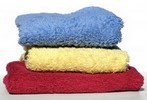Last updated on February 12th, 2018 at 07:52 pm
 Tips and Strategies to Avoid the Linen Closet Avalanche
Tips and Strategies to Avoid the Linen Closet Avalanche
It’s so easy to accumulate a large collection of mismatched and worn-out linens that crowd shelves in heaps, so jammed together that when you tug for a towel or reach for that yellow sheet, everything comes tumbling down.
 With these tips and strategies, whipping your linen closet into shape will be one of the easiest organizing projects you’ll ever tackle. And it’s an excellent way to feel that you have at least one organizing project completed and under control.
With these tips and strategies, whipping your linen closet into shape will be one of the easiest organizing projects you’ll ever tackle. And it’s an excellent way to feel that you have at least one organizing project completed and under control.
 Sort, Purge and Organize
Sort, Purge and Organize
First, sort all your towels and sheets into categories to determine which are worth keeping and which should go. Suggested categories are “Keep”, “Toss” and “Donate.” Turn worn-out and thread-bare towels and sheets into rags or garage dust covers.
How Much is Enough?
Have you ever thought about how much is enough when it comes to linens. A guideline that I follow is that you don’t need more than three sets of sheets per bed and as few as three sets of sheets or bath towels, hand towels, and washcloths per person (more if you change towels daily.) This number gives you one set in use, one in the hamper, and one in the closet ready for action. You’ll need only one or two sets for guests (one on the bed and one in the closet).
Don’t Hoard
Resist the temptation to hoard extra sets of sheets and towels for emergencies. Honestly, what emergency could occur that you would need extras, sheets and towels that really just sit in a closet and never see the light of day? Use the one-in/one-out inventory rule to keep your inventory under control. When you acquire a new set, retire an old one.
Give your Linens Room to Breathe
There are few things more refreshing than the fragrance of clean sheets and towels. But if your linen closet is crammed full, you’ll actually cause the opposite to occur. Textiles experts indicate that air flow is important to the safe storage of most textiles. If linens are crowded without room to breathe, the fibers retain moisture, which attracts mold, mildew and possible permanent damage to the fabric. Experts recommend airing out your linens every three months to eliminate trapped moisture. If you find you have musty smells in your linen closet, experts suggest that you can chase away mustiness with an open container of baking soda, activated charcoal, or calcium carbonate.

More Tips to Organize Linens
MarthaStewart.com also has great tips on Organizing a Linen Closet, with specifications for shelf heights, storage of antique linens and Pest Prevention.
Caring for Antique Linens
For detailed advice on caring for antique linens and heirloom treasures, see the Smithsonian article on How do I store antique textiles at home?
To gently bleach discolored linen or lace, first wash it in cool water, using soap flakes or liquid soap rather than detergent. Then lay the piece flat, on a white cloth, in direct sunlight. Let the sun’s rays have a chance to work some magic; sometimes, this is all that is needed to whiten old lace or linen.
If sun lightening does not work, try our grandmother’s method of gentle bleaching – fill a large pot with
water, allowing plenty of room for the lace or linen to move freely. Add 1/2 cup of baking soda or washing soda, and 1/2 cup of salt. Bring to a boil, then simmer for an hour. After an hour, remove the fabric, rinse in cool water, lay flat and let dry.
Natural Fragrance for a Linen Closet
Women have tucked herbal sachets in amongst their linens for centuries. Make simple lavender sachets by enclosing lavender buds in a square of muslin; gather up the corners and tie with embroidery floss, yarn or string.
